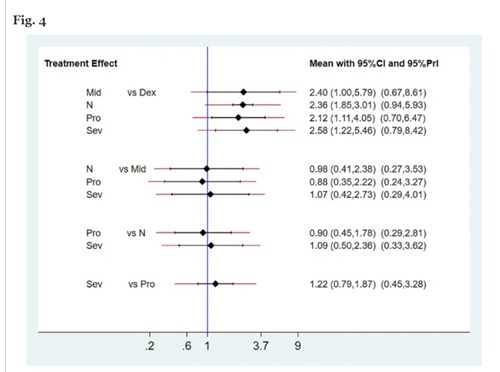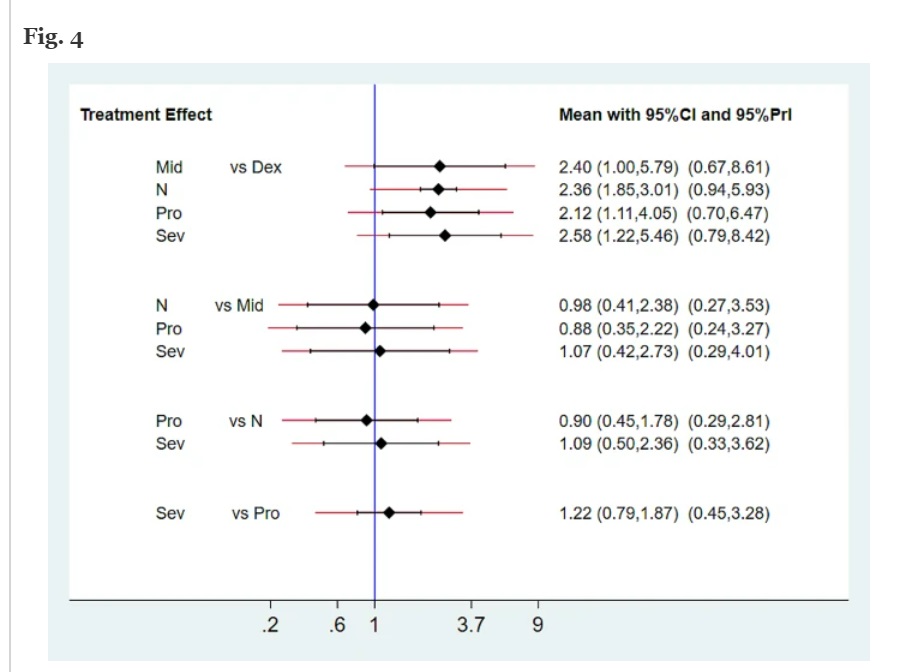Clinical Summary | Anaesthetics
The role of perioperative sedative anesthetics in preventing postoperative delirium: a systematic review and network-meta analysis
Time to read: 07:16 minutes
Time to listen: 11:33 minutes
Published on MedED: 23 October 2024
Originally Published: 6 March 2024
Source: BMC Cardiovascular Disorders
Type of article: Clinical Research Summary
MedED Catalogue Reference: MCECS014
Category: Anaesthesia
Cross-reference: Neurology, Surgery
Keywords: anaesthesia, surgery, cardiology, delirium, cognitive decline
Key Take Aways
1. Various factors, including age, type of surgery, and duration of intubation influence postoperative delirium.
2. Dexmedetomidine is effective in preventing postoperative delirium in both cardiac and non-cardiac surgeries.
3. The preventive effect of dexmedetomidine is more pronounced with longer surgical and extubation times.
4. Close monitoring is required during dexmedetomidine administration due to its association with bradycardia
Top
Study Context | Objectives | Study Design | Findings | Discussion| Limitations | Conclusion | Original Research | Funding | References
Postoperative delirium, also known as postoperative cognitive dysfunction (POCD), is a common complication after surgery, particularly in the elderly, with an incidence rate as high as 70%.1 It typically arises within 1 to 3 days post-surgery and can persist for 2 to 5 days, leading to prolonged hospitalisation, increased healthcare costs, and higher mortality rates. 2,3
Recent studies suggest links between postoperative delirium and long-term cognitive disorders.
This article reviews a meta-analysis of the preventive effects of four anaesthetic drugs—sevoflurane, propofol, dexmedetomidine, and midazolam—aiming to determine the safest and most effective intervention to reduce POCD risk.
Back to top
The stated purpose of this study is to " .. investigate whether there is an effective sedative that can prevent postoperative delirium while also examining the safety of using sedatives during the perioperative period.”
Back to top
This study employed a net-meta-analysis to compare the incidence of postoperative delirium among the four anaesthetics agents namely: sevoflurane, propofol, dexmedetomidine, and midazolam.
Trial Selection Criteria
Randomised control trials were selected based on the following specific criteria:
1. Participants were adults aged 18 or older and had no pre-existing conditions including dementia or cerebral infarction
2. The interventions involved comparing dexmedetomidine, sevoflurane, midazolam, and propofol with a saline group or placebo as controls
3. The primary outcomes measured were the incidence of postoperative delirium, diagnosed within seven days of surgery using validated tools, including Confusion Assessment Method and Mini-Mental State Examination scales
Definitions of Outcomes
• The primary indicator was the incidence of postoperative cognitive dysfunction (POCD)
• Secondary indicators included the incidence of hypotension, sinus bradycardia, operation time, and extubation time
• Hypotension was defined as a systolic blood pressure lower than 90 mmHg or diastolic blood pressure lower than 60 mmHg
• Sinus bradycardia was defined as a heart rate of less than 60 beats per minute.
Bias
The Cochrane Risk of Bias (ROB) tool-2 was employed to assess the risk of bias in each study, ranking each item and categorising it as high, medium, or low risk of bias.
Of the initial 4012 articles initially identified, 41 studies met the inclusion criteria, accounting for a total of 6679 patients:
- Twelve of the studies focused on cardiac surgery, 28 on non-cardiac surgery, and 1 on both cardiac and non-cardiac surgery.
- Six studies were conducted in the ICU, 33 studies were conducted in the OR, and two studies included both OR and ICU settings.
The following findings were recorded
Primary Index
Compared to dexmedetomidine, other sedatives, such as midazolam (odds ratio [OR] 2.40), propofol (OR 2.12; 95% CI 1.11 to 4.05), sevoflurane (OR 2.58; 95% CI 1.22 to 5.46), and saline (OR 2.36; 95% CI 1.85 to 3.01), are less effective at reducing the risk of postoperative delirium and postoperative cognitive dysfunction.
The figure below provides a pairwise comparison interval diagram. The comparison of several interventions in terms of their effectiveness in reducing postoperative delirium and Postoperative cognitive dysfunction
Figure 1: The pairwise comparison interval diagram. The comparison of several interventions in terms of their effectiveness in reducing postoperative delirium and Postoperative cognitive dysfunction
Click on the image to enlarge
```
Secondary Index and Sub-Analysis
1. Extubation
Propofol was associated with a higher risk of postoperative delirium and longer extubation times compared to dexmedetomidine (mean difference [MD] 350.58; 95% CI 323.78-377.38), midazolam (MD 344.28; 95% CI 316.98-371.57), and normal saline (MD 351.21; 95% CI 324.32-378.10).
Similarly, sevoflurane showed a higher incidence of postoperative delirium and longer extubation times compared to dexmedetomidine (MD 349.58; 95% CI 322.27-376.88), midazolam (MD 343.28; 95% CI 315.49-371.07), and saline (MD 350.21; 95% CI 322.82-377.60).
In a sub-analysis:
1. Dexmedetomidine administered within the first hour after surgery was more effective at preventing postoperative delirium compared to midazolam (OR 15.55; 95% CI 1.11-218.13) and normal saline (OR 3.48; 95% CI 1.75-6.94).
2. When extubation time exceeded 5 hours, propofol (OR 2.20; 95% CI 1.23-3.93) and normal saline (OR 2.63; 95% CI 1.09-6.31) were less effective at preventing delirium than dexmedetomidine, highlighting its superiority in both short and prolonged extubation scenarios.
2. Operation Duration
While operation time is a factor in the development of postoperative delirium, no significant differences were found in the impact of different operation times or drugs on its occurrence due to the influence of multiple factors.
In sub-analysis:
1. Patients who underwent surgeries lasting less than three hours had a significantly lower incidence of postoperative delirium when treated with dexmedetomidine (OR 2.74; 95% CI 1.48-5.05) compared to those given normal saline.
2. For surgeries lasting more than three hours, dexmedetomidine showed a significantly better preventive effect on postoperative delirium than other anaesthetic regimens.
3. Type of Surgery
Cardiac Surgery
The study included 12 articles focusing on cardiac surgery, comparing four drugs: propofol, sevoflurane, dexmedetomidine, and normal saline.
Results indicated that patients receiving midazolam (OR 3.34; 95% CI 2.04–5.48) and normal saline (OR 2.27; 95% CI 1.17–4.39) had a higher likelihood of developing postoperative delirium compared to those treated with dexmedetomidine.
Non-Cardiac Surgery
In a broader analysis of 28 articles comparing five drugs in non-cardiac surgeries, it was found that normal saline was associated with a higher risk of postoperative delirium compared to dexmedetomidine (OR 1.98; 95% CI 1.44–2.71).
4. Additional Secondary outcomes
Bradycardia was reported in 12 articles involving 1,831 participants, with a significantly lower incidence in the saline group compared to the dexmedetomidine group (OR 0.55; 95% CI 0.37 to 0.80). There were no significant differences in the incidence of bradycardia among other sedatives.
Additionally, of the 41 articles analysed, only 12 reported instances of hypotension, and the rates of hypotension for various drugs were not statistically significant.
The SUCRA indices indicated the effectiveness of the drugs in the following order: dexmedetomidine (98.8%), propofol (51.4%), saline (37.2%), midazolam (36.4%), and sevoflurane (26.2%).
Back to top
The researchers conclude that their analysis supports previous research and guidelines, which indicate that dexmedetomidine can effectively reduce the incidence of postoperative delirium.
Dexmedetomidine demonstrates this positive effect primarily through its activation of α2 receptors in the brain, which inhibits norepinephrine release, reduces neuron excitability, and enhances the inhibitory action of γ-aminobutyric acid (GABA). This mechanism promotes sedation, reduces anxiety, improves sleep quality, and accelerates recovery. Additionally, its anti-inflammatory and neuroprotective effects, achieved by regulating neuronal metabolism and the inflammatory response, contribute to its role in preventing delirium.
However, it is important to note that dexmedetomidine is associated with a higher risk of bradycardia compared to normal saline, though no significant difference was found in the overall rate of postoperative delirium between these groups, highlighting the multifactorial nature of the condition. When compared to other sedatives like midazolam, sevoflurane, and propofol, dexmedetomidine was more likely to cause bradycardia, but it did not significantly increase the risk of hypotension.
Furthermore, according to some guidelines, the duration of surgery is recognised as a risk factor for postoperative delirium, although studies differ on the specific time threshold that increases this risk. Ultimately, while dexmedetomidine shows clear benefits in preventing delirium, its potential side effects must be carefully managed in clinical practice.
Back to top
Limitations
The researchers noted thier net-meta-analysis has several limitation. Some studies had small sample sizes, with as few as 40 subjects, which could affect the generalisability of the findings. Additionally, the researchers only compared four sedatives and did not account for various factors influencing postoperative delirium, such as age, type and duration of surgery, and intraoperative medication. Lastly, the subjective nature of assessing postoperative delirium may impact the accuracy of the results.
Back to top
Conclusion
Based on their findings, the researchers conclude that dexmedetomidine is an effective sedative for preventing postoperative delirium in both cardiac and non-cardiac surgeries. Its preventive effects become more pronounced with prolonged surgical and extubation times, highlighting its utility in higher-risk scenarios.
However, clinicians should exercise caution when administering dexmedetomidine, as it is associated with an increased risk of bradycardia. Therefore, careful monitoring of heart rate and vigilance in managing potential side effects are essential when considering dexmedetomidine for patients, particularly the elderly, who may be more susceptible to postoperative complications, including postoperative delirium.
This study has been registered on PROSPERO as CRD42023426641
Back to top
Conflict of Interest, Funding and Support
Role of the Funder/Sponsor
The study's funder had no role in the design, data collection, data analysis, data interpretation, or writing of the report.
Conflict of Interest Disclosures
-Department of Anesthesiology, Second Affiliated Hospital of Army Medical University, Chongqing, China:
Jin-Xiang Huang, Shan-Shan Zhang, Shu-Xian Wang, Da-Shuang Xi, Fang-Ru Luo & Hong Li
-Department of General Medicine, Affiliated Anqing First People’s Hospital of Anhui Medical University, Anqing, China:
Cheng-Jiang Liu
Funding/Support
The research was funded by the National Nature funding (No:82171265).
Back to top
References
1. Saleh, A. J., Tang, G. X., Hadi, S. M., Yan, L., Chen, M. H., Duan, K. M., Tong, J., & Ouyang, W. (2015). Preoperative cognitive intervention reduces cognitive dysfunction in elderly patients after gastrointestinal surgery: a randomised controlled trial. Medical science monitor : international medical journal of experimental and clinical research, 21, 798–805. https://doi.org/10.12659/MSM.893359
2. Saczynski, J. S., Marcantonio, E. R., Quach, L., Fong, T. G., Gross, A., Inouye, S. K., & Jones, R. N. (2012). Cognitive trajectories after postoperative delirium. The New England journal of medicine, 367(1), 30–39. https://doi.org/10.1056/NEJMoa1112923
3. Rengel, K. F., Pandharipande, P. P., & Hughes, C. G. (2019). Special Considerations for the Aging Brain and Perioperative Neurocognitive Dysfunction. Anesthesiology clinics, 37(3), 521–536. https://doi.org/10.1016/j.anclin.2019.04.010
Back to top
Disclaimer
This article is in no way presented as an original work. Every effort has been made to attribute quotes and content correctly. Where possible, all information has been independently verified. The Medical Education Network bears no responsibility for any inaccuracies which may occur from the use of third-party sources. If you have any queries regarding this article contact us
Fact-checking Policy
The Medical Education Network makes every effort to review and fact-check the articles used as source material in our summaries and original material. We have strict guidelines in relation to the publications we use as our source data, favouring peer-reviewed research wherever possible. Every effort is made to ensure that the information contained here accurately reflects the original material. Should you find inaccuracies or out-of-date content or have any additional issues with our articles, please make use of the Contact Us form to notify us.






